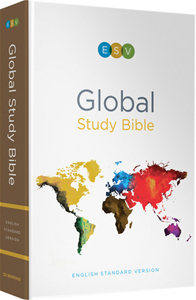ESV Global Study Bible. Ed. J. I. Packer, Wayne Grudem, and Ajith Fernando. Wheaton, Ill.: Crossway. 2012. 1984 pp. $29.99.
The number of study Bibles that had been produced in the last decade or so is not few. Each one offers itself as a unique tool for understanding the Bible better. There are study Bibles that are discipline-based (e.g., NIV Archaeological Study Bible [Grand Rapids: Zondervan, 2006]; KJV Archaeological Study Bible [Grand Rapids: Zondervan, 2010]), confession-based (e.g., The Reformation Study Bible [Orlando: Ligonier Ministries, 2008] with the ESV; The Wesley Study Bible [Nashville: Abingdon, 2009] with the NRSV), and religion-based (e.g., Jewish Study Bible [New York: Oxford University Press, 2004] with the JPS Tanakh; its NT counterpart The Jewish Annotated New Testament [New York: Oxford University Press, 2011] with the NRSV). The ESV Global Study Bible (henceforth, ESV-GSB) is yet another addition to the seemingly unending list of study Bibles beginning with the 1560 Geneva Bible, to the Scofield Reference Bible and the Thompson-Chain Reference Bible of the early 1900s, and the countless others in the more recent decades.
The ESV-GSB offers several helpful tools for any student of the Bible who can read English. These tools include: (1) essential theological overview of the Bible; (2) timelines of the OT and NT, and for each book of the Bible; (3) brief introduction that highlight the “universal themes” and the “global message” for each book of the Bible; (4) “fact boxes” offering insights based on observation about the life in the ancient times; (5) profiles of key characters in the Bible; (6) charts and diagram summarizing important concepts; (7) visual aids featuring building structures, cities, and objects; (8) maps with supplemental full-colored satellite image maps; (9) articles on key theological themes; and (10) glossary of important words and phrases (12). In addition to these features, cross-references are suggested, some textual variants are occasionally identified, and other study notes are provided for most verses.
Christian buzzwords in vogue in the recent years include “partnership,” “postmodern,” “discipleship,” and “global,” among others. This raises the question about what makes the ESV Global Study Bible “global”? The study notes ESV-GSB are essentially the same as those in the ESV Study Bible (Wheaton, Ill.: Crossway, 2008) with some additions, deletions, and
rearrangements of materials. The contributors of which are primarily Anglophone scholars. Aside from the these study notes interspersed with the biblical texts, there are supplementary articles and messages for the “global church” written by scholars who are from groups which are often underrepresented or unrepresented in works of similar nature to ESV-GSB. These supplementary articles apparently replaced the essays on hermeneutics and biblical interpretation, introductions for the various genres of biblical writings (e.g., prophetic writings, historical writings, Gospels, epistles), theological reflections, etc., included in the ESV Study Bible. What is it about the articles in the ESV Study Bible that is not “global” and about those in the ESV-GSB that makes it “global” remains puzzling to me.
Like any other study Bibles, the ESV-GSB, as a tool, can be no substitute for other resources (e.g., Bible dictionaries, atlases, concordances, lexicons) for studying the Bible. Nonetheless, useful materials are already made available in the ESV-GSB for anyone who, for whatever reasons, is not able to access Bible study tools. For those who already have study Bibles to use and have the means and opportunities to access the essential Bible study tools, the ESV-GSB may not be that much of a necessity; but for those who still do not have a study Bible and those want one that they would actually use, the ESV-GSB is one of the better ones to consider.
Review by Samson L. Uytanlet
Biblical Seminary of the Philippines
